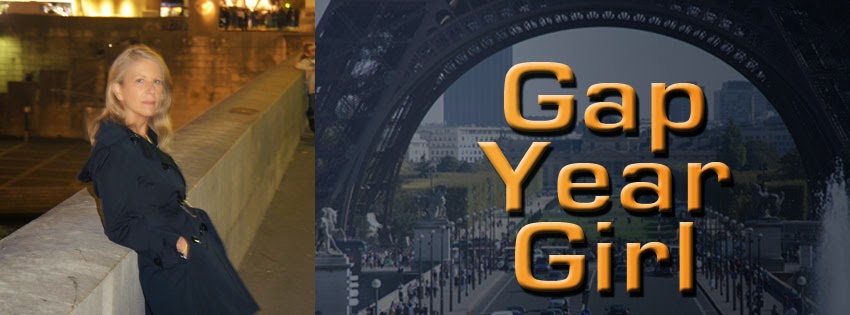The morning dawned under hazy sun and high clouds; it was
definitely going to be another hot one. We put on our shorts and T-shirts and headed
upstairs to the rooftop terrace for our first Turkish breakfast buffet. We had
no idea what would await us but the multi-tabled spread included the usual
suspects: yogurts, fruits, cereals, boiled eggs, cheeses, breads, jams, butter
and a few surprises like halva, tomatoes, cucumbers, olives and the Turkish version
of bagels with cream cheese schmears. Coffee and tea were in abundant supply
and we filled our cups to their brims.
I also noticed a lovely wine cart on wheels with a nice
variety of vintages tucked next to the coffee urns. The young man servicing the
buffet told me that in the evening, the breakfast-room-with-a-view turns into a
bar and that yes, wine and beer were indeed served. When I asked about the
availability of spirits in Istanbul and Turkey overall, he assured me that
while some establishments choose to abstain for religious reasons, many others
are available for wine-lovers like me. Phew, I thought and breathed a sigh of
relief – I was already starting to warm up to Turkey.
We grabbed our customary morning plates (yogurt and cereal
for me, cheese and eggs for Joe) and claimed a perfect table by the window. I
took a spoonful of yogurt and looking up, instantly lost my appetite. A sad and frankly upsetting
family scene was in progress just two tables in front of us. A T-shirted,
baseball-hatted man and an adorable little girl in a flowered sundress were
enthusiastically enjoying their bacon and eggs. Across the table from them, a woman
in a black, face-concealing burka was attempting to eat her own breakfast. I
watched in astonishment as she quickly lifted the heavy fold of veil and
surreptitiously slipped a forkful of scrambled eggs between her lips as if to
be observed eating was a depravity. Just as swiftly, she dropped the black
cloth so that her chewing mouth was once again hidden. Her husband and daughter
continued to revel in their morning repast while she struggled with every
agonizing bite. My stomach was in knots as I watched the woman attempt to get
through a meal in public. How can this be? I wondered. Does this woman
understand the shackles that bind her? Is this the future she wants for her
daughter who is now so carefree and spontaneous?
Over the course of our first days in Turkey, we witnessed
so many fathers
doting on their daughters, adorable creamy-skinned cherubs with soft blond
ringlets and olive-skinned beauties with silky dark manes. How can the power of
this misguided theology compel them in a few short years to subjugate these
beautiful young girls by hiding them under shrouds the minute they reach
puberty? Is a future of anonymity, of being covered and smothered what
they dream of for their daughters?
It’s going to take some time to reject the suppression of women in
Islamic countries, and it will take years, perhaps decades (and I pray not
centuries), but it’s eventually going to happen. It will be up to the younger
generations of women who connect in person and via the Internet with others not
bound by the strictures of their religion to envision possibilities for themselves
and carve out independent lives separate from their fathers and husbands. And
there will be young men who want their women independent and not just prizes or
trophies to be hidden.
I have four sisters, all of us strong, self-reliant, fiercely independent women, thanks in large
part to the way our parents raised and educated us, none of us willing to
relinquish who we are or what we look like for husbands, fathers or religion.
We’ll all go to great lengths to do what’s best for our children, but beyond
that, don’t try to tell us what to do, where to go or what to wear. I
envisioned my sisters all sitting beside me in the Lady Diana breakfast room,
open-mouthed with horror just as I was, watching this poor woman battling to
finish her meal.
Joe and I drained our coffee cups, packed up our things and headed for
the stairs. As I glanced back for a final look at the draped woman, I saw that
she had pulled a Blackberry from beneath the folds. Yes, I thought, bravo. It
won’t be long before communication leads to a yearning for dignity and independence.
I suddenly had hope for her daughter.
